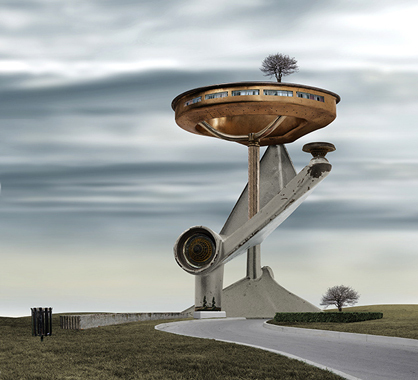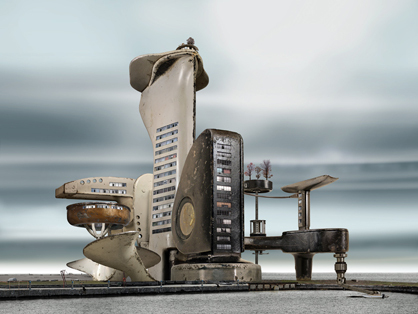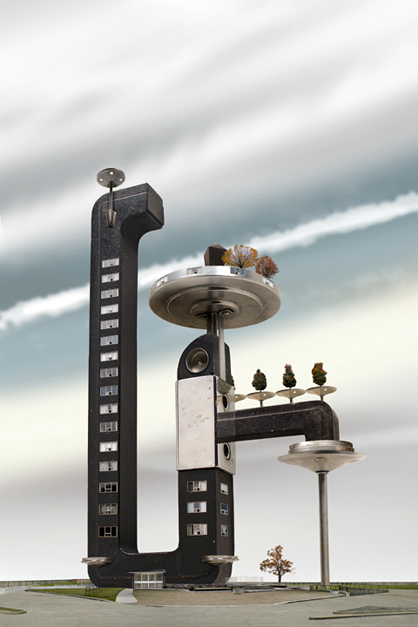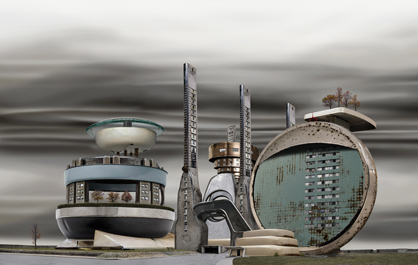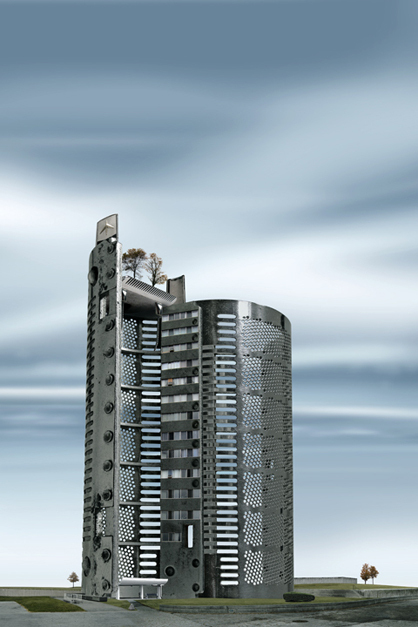Habitat Machines
Text von Nora Schmidt
Berlin, Deutschland
26.03.09
Science Fiction – die Welt nach ihrem Untergang im Jahre 2347. Grob umschrieben könnte das der erste Eindruck sein, den die Fotomontagen des kanadischen Künstlers Dave Trautrimas vermitteln.
Science Fiction – die Welt nach ihrem Untergang im Jahre 2347. Grob umschrieben könnte das der erste Eindruck sein, den die Fotomontagen des kanadischen Künstlers Dave Trautrimas vermitteln. Die heruntergekommenen, futuristischen Fabrikgebäude sind ausgediente Haushaltsgeräte, die Trautrimas in neuem Kontext inszeniert.
Durch die Montage von architektonischen Elementen wie Fenster und Treppen, verwandelt er die Utensilien in überdimensionale Gebäude, in hochskalierte Megaskulpturen – eine Analogie zur häufig merkwürdig proportionierten Architektur des heutigen Dubai ist kaum zu verleugnen.
Die Industrielandschaften von Dave Trautrimas sind ein Spiel mit Proportionen. Funktioniert eine Staubsaugerdüse auch im Massstab eines 20-stöckigen Hochhauses? Wie verhält sich ein solches Gebäude im Zusammenhang mit seiner Umgebung und wie wirkt es auf seine Bewohner?
(Interview nur in englisch)
Dave, you scale up objects and put them into a new context, you basicly transform them into architecture. What brought you to this idea?
To be honest it can be traced back to a childhood obsession with Lego toys. I thoroughly enjoyed being able to take a handful of blocks and creating dozens of objects different in scale & use. As an art student I developed the skills to bring that kind of manipulation to my own source materials, starting with rudimentary digital collages combining corporeal & architectural elements. As my abilities progressed I began looking at common objects as my lego blocks, wondering how I can take them apart and rebuild them into something completely different. This approach was first expressed as architecture in my previous body of work, Industrial Parkland, in which objects such as staplers and lamps where dismantled and turned into a stapler factory or a lamp factory. Habitat Machines is a continuation of that approach, but with residential instead of industrial buildings.
Where do you see the differences between architecture and product design?
Aside from the obvious technical distinctions of construction vs. manufacturing I don't really see a difference. For example a Geary building, or an Eames chair, transend their utilitarian purpose and can be seen as works of art. If done poorly and without inspiration a condo tower can be boring & utilitarian as toilet paper. When it comes down to it how different are the atilliers of Zhaha Hadid & Jonathan Ive? They both strive to bring exceptional design to buildings or products seen & used my the masses, with the only difference being the physical size of what they create.
Some of your works remind me of new architecture in Dubai. What do you think about this developement of mega-sculptures?
I find it incredible and thoroughly enjoying. Its like a race to see how far architecture and construction can be pushed against the limits of cost & sensibility. For example the rotating David Fisher buildings seem absurd, if not precarious, but no where else in the world has the audacity to try something like it. If I'm ever to get one of my creations built it will be in Dubai for sure.
Dave Trautrimas 'Habitat Machines' sind bis 24. April 2009 im Rahmen der 'Visual Morphology' Ausstellung in der New Yorker Klompching Gallery zu sehen.


